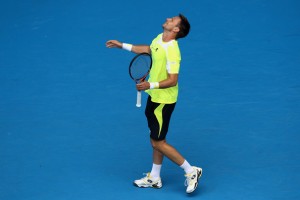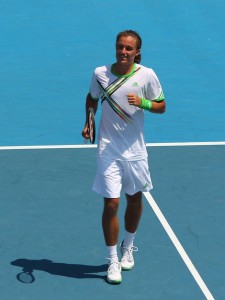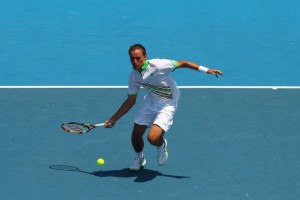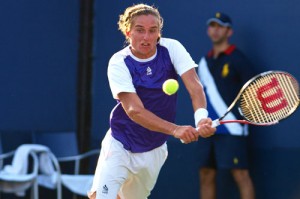Alexandr Dolgopolov: Rising Star in Men’s Tennis?
Robin Soderling is one of the biggest men in pro tennis, at 6’4” and nearly 200 pounds.
He has ridden one of the most overpowering serve-and-forehand combinations in the game’s history to a ranking of No. 4 in the world, scoring wins over the game’s biggest names.
And his personality, while less prone to controversy than it was just two years ago, could hardly be described as “warm.” I say all of this as a way of illustrating that the big Swede has rarely, if ever, been one to elicit sympathy.
Yet in the fourth set of his fourth-round Australian Open match, I couldn’t help but feel for the guy a little. Having battered his way past his first three opponents, he had won the first set easily, was up a break in the second and looked headed for a showdown with fellow Slam contender Andy Murray.
Then suddenly his opponent, Alexandr Dolgopolov of Ukraine, caught fire, winning five of the last six games of set two and routing the Swede 6-1 in set three.
Suddenly, I was rooting for Soderling to win the fourth, if not the match, in the hopes of that he could leave the court having restored some respectability.
He did capture set four, forcing his streakier, less experienced opponent to play a fifth. That was a challenge Dolgopolov was up to, however, winning the final set 6-2.
As big a ball as Soderling hits – and its as big as anyone today – players such as he are always vulnerable to evolutions in the sport, as a player who relies almost entirely on serving and baseline power has little answer when another player learns how to hit bigger than he does.
It’s happened many a time in the Open Era, to Jimmy Arias, to Jim Courier, to Andy Roddick.
He’s not an outdated product yet – he’s won two titles just since his AO debacle – but it’s a near-certainty he will be eventually.
While Soderling is the latest variation of a type of player we’ve seen before, Dolgopolov has fewer such precedents. After he upset the Swede one could see analysts straining to find a reference point for his flashy, unpredictable shotmaking; Lleyton Hewitt was used as one once.
This comparison, though, may have a lot more to do with their physical similarities; the Ukrainian prodigy and the former No. 1 Aussie are separated by no more than an inch in height, and Dolgopolov’s wispy build and long blonde hair do recall Hewitt circa-2000.
As players, though, they share little aside from great speed and athleticism.
From a very young age Hewitt was a master of point construction and savvy play whose slight form had to catch up to his well-built mind. For a time, this combination made him the best in the world, but offered little additional room for growth after 2004.
Dolgopolov’s progression has been quite the opposite: Following a youthful bout with disinterest in the sport, the Ukrainian has only recently begun to play like he cares again, and his game still seems a work in progress at times: One of the reasons he fell behind Soderling in Australia was because his first-serve percentage hadn’t even cracked 30 in the first set.
And in the next round, Andy Murray looked immensely relieved to be through with him in four sets, as his hit-or-miss style had left the Scot unsure of what tactics to employ for much of the match.
For though he resembles Hewitt’s appearance, his game reminds me of no one so much as the streaky Czech Petr Korda. There are some definite differences: a 6’3” lefty with a brilliant one-handed backhand, Korda had a more classical game that could make use of greater serving power.
Dologopolov is 6’0”, right-handed and uses two hands on the backhand, making him quicker and more inclined to counterpunching.
But both men’s greatest knack is their timing, catching the ball earlier than most players – even most pros– can imagine.
While their pace threshold may be somewhat more limited than Soderling’s or Courier’s, these guys still hit a phenomenal degree of power with a minute backswing, and at their best treat notions like “court positioning” and “high-percentage shots” as the concerns of lesser beings.
All of which makes Dolgopolov the most exciting new player to come around in years, at least since Novak Djokovic. Unlike Djokovic circa 2007, though, I’m not completely convinced that Grand Slam titles are in his future. Age 19 seems to have become a critical point for the winners of majors, and not just for extreme cases like Rafael Nadal, who won his first only days after his 19th birthday.
Think about it: Hewitt was 19 when he reached his first Slam semi in 2000, the same year he won the US Open in doubles. Djokovic was that age when he won his first Master’s Shield in Miami 2007, beating Nadal on the way. Roger Federer, at age 19, topped Pete Sampras at Wimbledon.
Dolgopolov, thanks to that previous spell of disinterest in the game, is only now making noise despite being 22. This gives him a narrower window than the names listed above, and all but precludes him from than stratospheric results achieved by Nadal and Federer.
But the window is not closed completely; Dolgopolov can still get a lot better from a strategic standpoint, and can still become more physically imposing. If he does so by age 25, his chances of sweeping away one Slam or more are very good.
If he does so sooner, Robin Soderling isn’t the only one I’ll be feeling sorry for.














